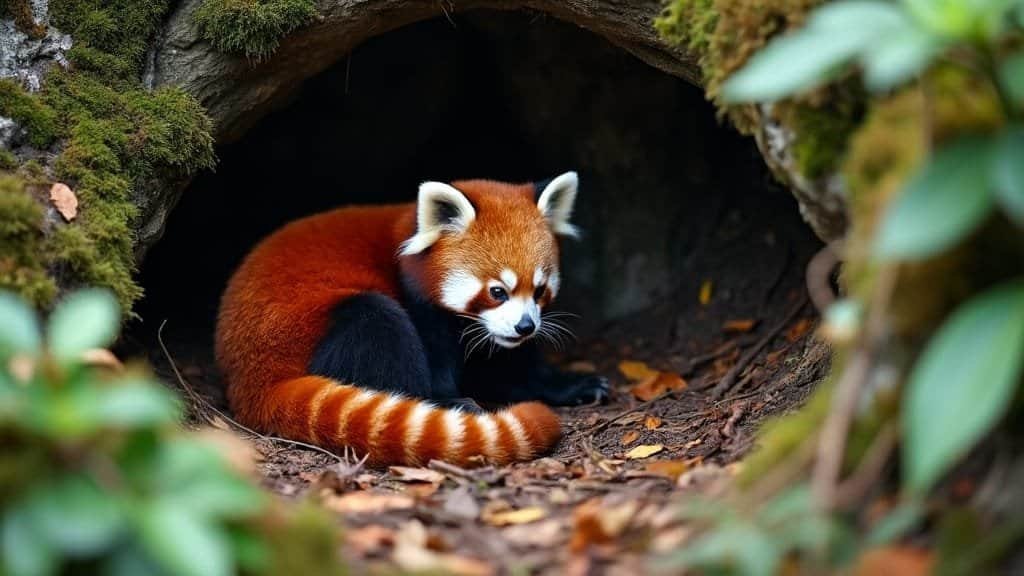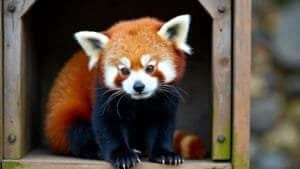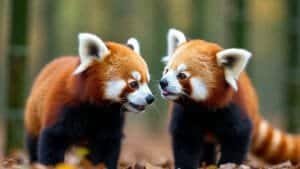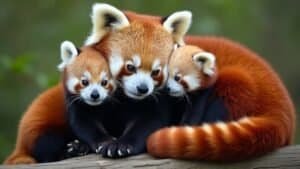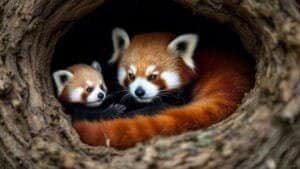Red panda mothers exhibit remarkable nesting behaviors to ensure the safety and survival of their cubs. In the wild, they seek out natural dens in tree hollows, rock crevices, or dense vegetation, carefully selecting locations that provide insulation and protection from predators. As birth approaches, the mother meticulously lines her den with soft materials such as leaves, moss, and twigs, creating a warm and secure environment for her vulnerable newborns
These dens serve as the cubs’ primary shelter for the first few months of life, offering both warmth and concealment. In captivity, red panda mothers display similar instincts, utilizing specially designed nesting boxes provided by zookeepers. Understanding these maternal behaviors is crucial for conservation efforts, as habitat loss and climate change continue to threaten the availability of suitable nesting sites in the wild
This article will explore how red panda mothers prepare their dens, the materials they use, and the role these nests play in cub survival
Nesting Behaviors of Red Panda Mothers

Red panda mothers invest significant time and effort in preparing their dens before giving birth, ensuring a safe and comfortable space for their cubs. As highly solitary animals, they take full responsibility for selecting and modifying a nest that will protect their offspring during the critical first months of life
Their nesting behaviors are instinctive and highly adapted to their natural environment, with den selection, nest construction, and maintenance being essential aspects of successful cub rearing
How Red Panda Mothers Choose a Den Location
The selection of a nesting site is one of the most critical steps in a red panda mother’s preparation for birth. In the wild, females search for well-hidden locations that provide both insulation and security. Tree hollows, rock crevices, or dense bamboo thickets are common choices, as they offer protection from harsh weather and potential predators such as snow leopards and martens
These locations also provide natural camouflage, reducing the chances of the den being discovered. The chosen site must also be close to a reliable food source, allowing the mother to leave the den briefly for feeding while ensuring she can quickly return to her cubs. In captivity, red panda mothers adapt to artificial dens, typically using wooden nest boxes provided by zookeepers. These enclosures mimic the enclosed, elevated spaces they prefer in the wild and are lined with soft bedding materials to replicate natural nesting conditions
Materials Used in Red Panda Nest Construction
Once a suitable den is chosen, the mother begins gathering materials to insulate and cushion the nest. Leaves, moss, grass, twigs, and bark are carefully arranged inside the den, forming a thick, warm lining that helps regulate temperature and provides a soft resting surface for newborn cubs. This insulation is especially important in cold mountain habitats, where temperatures can drop significantly at night
The mother continuously modifies the nest, adding fresh materials as needed to maintain warmth and comfort. In captivity, red pandas display similar behaviors, often shredding available bedding materials such as straw or hay and rearranging them inside their nesting boxes. Studies on captive breeding programs have shown that providing a variety of nesting materials encourages natural behaviors, leading to higher cub survival rates
Timing and Preparation of the Nest Before Birth
Red panda mothers begin nesting preparations well in advance of giving birth, with significant activity occurring in the final weeks of pregnancy. Nesting behaviors typically intensify one to two weeks before labor, as the mother becomes increasingly focused on reinforcing the structure of the den. She may spend long periods inside, rearranging materials and testing different positions to ensure the space is suitable for cub-rearing
In the final days before birth, she isolates herself almost entirely, retreating into the den and limiting her activity outside. This seclusion helps reduce stress and minimizes exposure to threats, allowing her to focus entirely on the upcoming birth. In zoo environments, caretakers observe this nesting phase closely, often noting increased time spent in dens and a decline in scent-marking behaviors, both indicators that birth is imminent
For more insights into red panda nesting behaviors, explore this resource on maternal care in red pandas
Environmental and Protective Functions of the Den

Red panda dens serve as critical shelters that provide warmth, safety, and isolation for newborn cubs. Since red panda cubs are born blind and helpless, they rely entirely on the security of the den and their mother’s care for survival. The selection and maintenance of a proper den are essential to shielding them from environmental hazards, predators, and sudden climate changes
How the Den Provides Security for Newborn Cubs
A well-constructed den is the cubs’ first line of defense against potential dangers. Red panda mothers instinctively choose locations that are hidden, enclosed, and difficult for predators to access. Tree hollows and rock crevices provide natural fortification, reducing exposure to predators such as snow leopards, eagles, and martens
Dense vegetation surrounding the entrance helps camouflage the den, making it less visible. Unlike other mammals that may aggressively defend their offspring, red panda mothers rely on secrecy and isolation to keep their cubs safe. In cases where the den becomes compromised—either due to environmental factors or disturbances—the mother may choose to relocate her cubs to a secondary den to ensure continued safety
The Role of Temperature and Insulation in Nesting
Temperature regulation is another key function of the den, particularly in the high-altitude forests of the Himalayas and China, where red pandas live. In colder months, tree hollows and rock crevices offer natural insulation, reducing heat loss and keeping cubs warm. Mothers further enhance this insulation by adding layers of leaves, moss, and fur, which help retain warmth
Cubs rely on their mother’s body heat in the early weeks, as they are unable to regulate their own temperature. In warmer climates, red pandas may choose dens with better airflow, ensuring cubs do not overheat. The effectiveness of the den’s insulation directly impacts cub survival, as exposure to extreme temperatures can be fatal for fragile newborns
In captivity, keepers monitor den temperatures closely to ensure they mimic natural conditions. Temperature-controlled enclosures provide additional warmth when necessary, and nesting boxes are designed with ventilation and insulation in mind. This controlled environment helps offset the risks that wild cubs face, contributing to higher survival rates in managed breeding programs
Threats to Red Panda Dens in the Wild
While red panda dens are carefully chosen to provide security, they are not immune to external threats. Deforestation and habitat destruction are among the biggest challenges, reducing the availability of suitable denning sites. Logging, agriculture, and infrastructure development have fragmented red panda habitats, forcing mothers to nest in less secure locations that may not provide adequate protection
Climate change also poses risks, with shifting temperatures and altered weather patterns affecting the suitability of traditional denning areas. Increased rainfall, for instance, can flood dens, while warming trends may disrupt the timing of cub births, leading to mismatches in food availability
Predation remains another constant threat, with snow leopards, raptors, and martens occasionally preying on cubs if they discover a vulnerable den. Human disturbances, such as eco-tourism, poaching, and encroachment into red panda habitats, can also disrupt maternal behaviors. If a mother perceives repeated disturbances near her nest, she may be forced to relocate her cubs, which can increase stress and reduce survival chances
Conservation efforts aimed at preserving old-growth forests and reducing human impact are crucial in protecting these essential nesting environments. For more details on how zoos and conservation groups help protect red panda nesting sites, check out this article on red panda reproduction
Differences Between Wild and Captive Red Panda Nesting

The nesting behaviors of red pandas remain largely consistent across wild and captive environments, but certain adaptations emerge due to differences in habitat stability, resource availability, and human intervention. While wild red pandas must independently locate and prepare safe denning sites, captive individuals benefit from controlled environments designed to support successful reproduction
How Captive Red Pandas Adapt to Artificial Nesting Sites
In the wild, red pandas rely on natural structures such as tree hollows, rock crevices, and dense vegetation to build their dens. In captivity, however, zoos and breeding programs provide custom-designed nest boxes that mimic these natural environments. These enclosures are typically made of wood and include insulated walls, soft bedding, and temperature controls to replicate the warmth and security of a tree cavity
Captive red pandas instinctively engage in nesting behaviors, collecting and arranging hay, straw, or shredded bark to create a comfortable space for their cubs. Since food is readily available in captivity, these pandas do not need to select dens based on proximity to food sources, giving them more flexibility in their choices
Zookeepers also closely monitor nesting behaviors to anticipate birth. Changes in activity, such as increased time spent in the nest box, reduced appetite, and decreased scent-marking, signal that a female is preparing for labor. Unlike in the wild, where den security depends on natural camouflage and seclusion, captive red pandas benefit from predator-free environments, allowing them to focus solely on cub-rearing without external threats
Do Red Panda Mothers Relocate Cubs After Birth?
Den relocation is a survival strategy used by red panda mothers to protect their cubs from potential threats. In the wild, if a den becomes unsafe due to predators, environmental disturbances, or extreme weather, the mother may move her cubs to a secondary location. This relocation process involves the mother carrying cubs one by one to a new, more secure nest. Studies on wild red pandas in Nepal have documented mothers using multiple den sites within a single breeding season, demonstrating their ability to adapt to changing conditions
In captivity, den relocation is rare since the environment remains stable and undisturbed. However, if zookeepers need to intervene for medical reasons, they may observe maternal reactions similar to wild relocation behaviors. Some captive red pandas display heightened protective instincts, moving their cubs deeper into the nesting box or covering them with additional bedding materials when sensing disturbances. This instinctual response highlights the importance of minimizing human interaction during the early stages of cub-rearing
Conservation Efforts to Protect Red Panda Nesting Habits
Efforts to protect red panda nesting behaviors focus primarily on habitat conservation and responsible breeding programs. In the wild, the most effective strategy is preserving old-growth forests, which provide the tree cavities and rock formations necessary for denning. Conservation organizations such as the Red Panda Network work to establish protected reserves and reforestation projects, ensuring that wild red pandas have access to suitable nesting environments. In addition, community-based conservation initiatives educate local populations on the importance of maintaining forest ecosystems and reducing human-wildlife conflict
Captive breeding programs play a complementary role by maintaining genetically diverse populations and reintroducing individuals into the wild when necessary. Zoos and conservation centers collaborate to refine best practices for red panda nesting, using behavioral studies to optimize den design and minimize stress in pregnant females. Advances in GPS tracking and camera monitoring allow researchers to study wild nesting behaviors in greater detail, providing insights that inform both in-situ (wild) and ex-situ (captive) conservation strategies
For more information on how conservationists support red panda reproduction, explore this educational resource on raising red pandas
